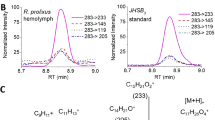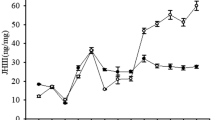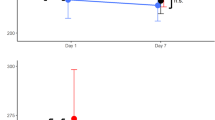Abstract
Extensive investigations of the environmental factors influencing the alate–apterous dimorphism of the summer, parthenogenetic, virginoparous generations of aphids have shown that crowding has a major influence on the development of the alate morph, although temperature and nutrition are also important1,2. These factors may act prenatally, postnatally or both, depending on the species. However, the physiological control of this dimorphism within the individual has not been elucidated. As the apterous adult and the larvae share certain morphological features3 it has been suggested that the hormone controlling larval–adult metamorphosis, juvenile hormone (JH), also influences development of apteriform characteristics4,5. Indirect evidence from measurements of corpus allatum (CA) volumes and CA nuclei were believed to support this theory6 and early experiments with topically applied JH extracts and analogues seemed to divert alate development towards the apterous condition2,5. Attempts to obtain more direct evidence have been negative or inconclusive6. Recently, Lees7 has questioned this hypothesis, citing the following evidence: (1) examination of more extreme forms produced by topical application of JH mimics to middle instar alatae shows them to be developing towards a fifth instar, supernumerary larva (that is juvenilization) rather than towards an apterous morph (that is apterization); (2) in an autumn, short-day-induced alate morph of Aphis fabae, namely the gynopara (see below), authentic apterization can be effected by postnatal exposure to long photoperiods, the first larval instar being most sensitive to this treatment. By contrast, it was the late second and the third instars that were most sensitive to juvenilization following topical application of JH analogues. It is shown here that larger doses of a more active hormone (JH1) will closely mimic the photoperiodic apterization of these gynoparae but that apterization is not due to the neotenic action of JH. Evidence is also presented suggesting that the alateapterous dimorphism in summer, long-day generations is not controlled by JH.
This is a preview of subscription content, access via your institution
Access options
Subscribe to this journal
Receive 51 print issues and online access
$199.00 per year
only $3.90 per issue
Buy this article
- Purchase on Springer Link
- Instant access to full article PDF
Prices may be subject to local taxes which are calculated during checkout
Similar content being viewed by others
References
Hille Ris Lambers, D. A. Rev. Ent. 11, 47–78 (1966).
Lees, A. D. Adv. Insect physiol. 3, 207–277 (1966).
Kennedy, J. S. & Stroyan, H. L. G. A. Rev. Ent. 4, 139–160 (1959).
Johnson, B. Ent. exp. appl. 2, 82–99 (1959).
Lees, A. D. in Insect Polymorphism (ed. Kennedy, J. S.) 68–78 (Roy. Ent. Soc., London, 1961).
Hales, D. F. in Phase and Caste Determination in Insects. Endocrine Aspects (ed. Luscher, M.) 105–115 (Pergamon, Oxford, 1976).
Lees, A. D. Nature 267, 46–48 (1977).
Kennedy, J. S. & Booth, C.O. Ann. appl. Biol. 41, 88–106 (1954).
Kennedy, J. S. & Booth, C.O. Ann. appl. Biol. 38, 25–64 (1950).
Shaw, M. J. P. Ann. appl. Biol. 65, 191–196 (1970).
Mittler, T. E., Nassar, S. G. & Staal, G. B. J. Insect Physiol. 22, 1717–1725 (1976).
Lees, A. D. in Comparative Endocrinology (eds Gaillard, P. J. & Boer, H. H.) 165–167 (Elsevier, Amsterdam, 1978).
Author information
Authors and Affiliations
Rights and permissions
About this article
Cite this article
Hardie, J. Juvenile hormone mimics the photoperiodic apterization of the alate gynopara of aphid, Aphis fabae. Nature 286, 602–604 (1980). https://doi.org/10.1038/286602a0
Received:
Accepted:
Issue Date:
DOI: https://doi.org/10.1038/286602a0
This article is cited by
-
Endocrine regulation of predator-induced phenotypic plasticity
Oecologia (2014)
-
Wing dimorphism in aphids
Heredity (2006)
-
A sex-linked locus controls wing polymorphism in males of the pea aphid, Acyrthosiphon pisum (Harris)
Heredity (2002)
Comments
By submitting a comment you agree to abide by our Terms and Community Guidelines. If you find something abusive or that does not comply with our terms or guidelines please flag it as inappropriate.



